By Heidi Madden
On the crisp, clear afternoon of December 7, 1924, ships passing through Puget Sound on their way to Elliott Bay were treated to a surprise: On a ridge high above the Sound, just north of Seattle, a new 600-square-foot American flag had been hoisted. The impressive symbol, meant to be the “first sight of Seattle†for ships bound for Elliott Bay, marked the official opening of the new Olympic Golf and County Club.
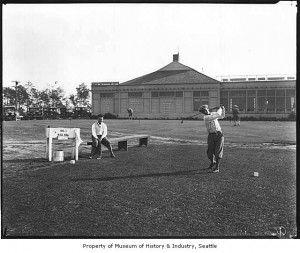
Golf Club Manager Douglas McLeod McMillin and Club President William M. Bolcom had the honor of hoisting the flag for the first time to the top of its 118-foot pole next to the new club house located at about 20th Ave. NW and NW 89th Street. The flag’s inauguration took place in front of about a hundred spectators, many of whom were visiting the new golf course for the first time.
Work on the new course began in May of 1924 on the picturesque site. Architect Francis James actively oversaw the work, and while Bolcom was publicly dedicated to opening the course to golfers in late fall, James was less convinced that the deadline could be met. But in late October of 1924, the new course was unofficially opened to the public – ahead of schedule.
The 18-hole course, at the time just north of the Seattle city limits, was an L-shaped property that stretched east to west from 15th Ave. NW to 24th Ave. NW. Its longest north-to-south line was on its west side, where it stretched from NW 95th Street to NW 85th Street.
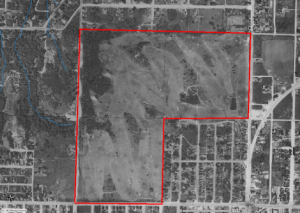
Bing’s Favorite Swing
The course was designed to challenge seasoned golfers, and it attracted many legends and pioneers of the sport: Tommy Armour, aka “The Silver Scot,†winner of the 1927 U.S. Open and the 1931 British Open; Macdonald “Mac†Smith, whose full-swing technique Bing Crosby admired; Johnny Farrell, winner of the 1928 U.S. Open; and Horton Smith, who in 1934 was the first winner of the new Augusta National Invitation Tournament, later named The Masters Tournament.
Perhaps the club’s most notable visitor was the charismatic and impeccably dressed Walter “The Haig†Hagen, five-time PGA Championship winner who, in 1922, was the first native-born American to win the British open. But more important to some local fans, in 1929 Hagen broke the Olympic Golf Club mark by scoring a 68 while paired with Horton Smith in an exhibition match against the club professional and an ace amateur.
Guns and Roses
Olympic Golf Club’s attractive clubhouse was a preferred venue for many lavish wedding receptions, parties, dances and musicals. A later installment to the golf course was less glamorous: The U.S. Army set up an anti-aircraft battery and housing for the personnel manning it.
From Legends to Lights
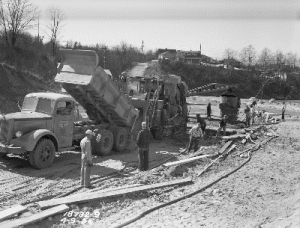
As late as the summer of 1953, golfers enjoyed the course. Green fees for the public at the time were $1.50 on week days and $2.00 on weekends. But in a post-war Seattle hungry for housing, the inevitable bulldozers were never far away. Later that year, plans to develop the property were made public, and by the mid-1950s, the golf course had been developed into building lots with sweeping views of Puget Sound and the Olympic Mountains. Olympic Manor was born.
The lots sold for up to $4,590 and included upscale improvements like sidewalks. The stately brick entrance constructed on its south border lent further distinction to the development. Schools (now North Beach Elementary and Whitman Middle School) and a playfield (now Soundview Playfield) were also in the planning stages and would occupy large portions of the former golf course.
Howard A. Parker, president of Picture Floor Plans, which in 1955 was the listing office for the development, said, “Olympic Manor is probably the last large tract of land within the city limits which will lend itself to a restricted, exclusive district.†[1]
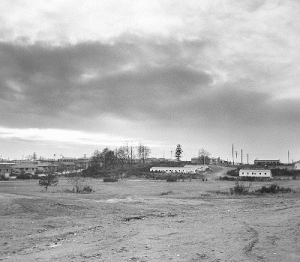
Parker went on to predict that the new neighborhood would maintain its original standards. Time has proved him right. The flag is long gone, along with the fairways, sand traps and legends of the past. But these have been replaced with something the entire city can enjoy: Olympic Manor’s magnificent annual holiday light display – a display that only such a committed and creative community could pull off.
Footnotes:
[1] Seattle Daily Times, January 16, 1955.
Sources:
- Seattle Daily Times, May 11, 1924, October 26, 1924, December 8, 1924, November 8, 1926, June 29, 1952, June 5, 1953, November 15, 1953, January 16, 1955, July 7, 1957
- Kroll May Company Atlas of Seattle, North Supplement, 1930 / 1964
- http://en.wikipedia.org,wiki/Tommy_Armour
- http://en.wikipedia.org,wiki/Johnny_Farrell
- http://en.wikipedia.org,wiki/Walter_Hagen
- http://en.wikipedia.org,wiki/Masters_Tournament
- http://en.wikipedia.org,wiki/Macdonald_Smith
- www.seattleschools.org
- www.kingcounty.gov/operations/gis/Maps/iMAP.aspx
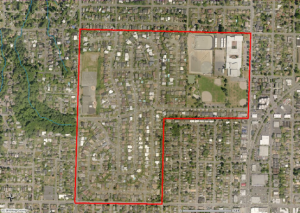

Many thanks to Heidi Madden who researched and contributed this great article about the Golf Course. We’re looking for historical photos of the golf course or the Army gun emplacement, or early life in Olympic Manor. If you’ve got something to share and add to the article, please contact dennis@crownhillneighbors.org
If you know of other Crown Hill stories, history, persons of interest, or want to suggest something which might be interesting to research and publish on the website, please contact me dennis@crownhillneighbors.org
Great article Heidi! The Old photo from 1925 and the aerial photos from 1936 & 2007 are fantastic. Good Job!
Would be nice to have those greens fees still and a course close at hand. Nice article! Now I have a great story to share with my ex father in law.
My father, Bert Swift Sr, used to be a greenskeeper at the Olympic Club, working four hours in the morning mowing greens, fixing divots, and seeding the fairways before he went off to work as a Linotype operator at the Seattle Times.
I used to caddy there while in junior high school. We recieved 35 cents for nine holes, or 50 cents for full eighteen. There were no golf carts, gas or electric in those days, and pull carts were rare.
In the winter, we sledded and skiid down the hills
Terrific post. I’d love to see some expansion on the details. Amazing to think of the transformation in so few years.
-Dean